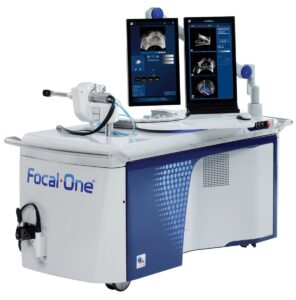HIFU Treatment in Treasure Valley
What Is High-Intensity Focused Ultrasound (HIFU)?
HIFU technology ablates prostate tissue by focusing high-intensity ultrasound waves on the affected area, causing localized heating that destroys the cells in the gland without damaging the healthy surrounding tissue. Focused ultrasound works in the same way as rays of sunlight that pass through a magnifying glass and are concentrated at a single point, equally causing a significant temperature to rise around the focal point.
Idaho Urologic Institute is committed to providing cutting-edge prostate cancer treatments, including HIFU, to patients in Treasure Valley. This non-invasive procedure offers precise cancer treatment with minimal impact on surrounding healthy tissue, reducing the risk of side effects. Call (208) 639-4900 today to schedule a consultation and explore whether HIFU is the right option for you.
Advantages Of HIFU Treatments
HIFU is the ideal treatment tool to ablate just the diseased part of the prostate for the optimal preservation of quality of life. HIFU is the latest treatment option using focal therapy to treat prostate cancer. The real-time imaging allows for precise local ablation in one session under general anesthesia, repeatable, if necessary, with a low risk of side effects.
– Non-invasive Procedure with no blade, no scar, no radiation, or incision
– Low Risk of Side Effects such as incontinence and erectile dysfunction
– Quality of Life Preservation with minimal time away from work and leisure activities
The Principle of HIFU
High-Intensity Focused Ultrasound (HIFU) uses an ultrasound probe to deliver high-intensity sound waves at a precise point. The magnitude of ultrasound energy delivered rapidly raises the temperature at the focal point, causing coagulation necrosis without damaging healthy tissue and structures outside the targeted area.
Focal One HIFU Procedure Steps - How A Treatment Works
IMAGING OF THE PROSTATE
The whole prostate is scanned by the transrectal ultrasound imaging probe and displayed on the Focal One screen as a three-dimensional reconstruction of the area to be ablated.
- PROSTATE TREATMENT PLANNING
On the screen, the urologist plans each step of the procedure, precisely targeting the area to be ablated.
- HIFU ENERGY DELIVERY
Finally, the system automatically determines the optimal number of lesions based on the planning and produces High-Intensity Focused Ultrasound waves to destroy the targeted cells.
What Happens After Your HIFU Procedure?
At the end of the procedure, a temporary urinary catheter will be placed in order to limit the risk of urinary retention due to the temporary swelling. You will be discharged and can return home rapidly after the end of the procedure. The catheter will be removed at the first follow-up visit just a few days later. Typical follow-up will include PSA testing at three months, six months, and one year, as well as an MRI image and potentially follow-up biopsies at one year to evaluate the result. This follow-up can be performed by the treating urologist, or if you traveled from a remote location, your local urologist.
Clinical Data
In a recent study, Focal One Robotic HIFU proved to have comparable oncological control while offering significantly lower negative impact on functional outcomes when compared to radical prostatectomy.
In this large, prospective study on more than 3,000 patients treated across 46 centers, Focal One Robotic HIFU produced better results for men’s urinary continence and erectile function compared to patients who received surgery.
Schedule a HIFU Consultation in Treasure Valley
At Idaho Urologic Institute, we offer advanced HIFU treatment in Treasure Valley to provide a precise, non-invasive option for prostate cancer with minimal side effects. Our expert team ensures personalized care, preserving your quality of life while delivering effective results. Contact us today at (208) 639-4900 to schedule a consultation and learn more about your treatment options.
Sources:


 IMAGING OF THE PROSTATE
IMAGING OF THE PROSTATE